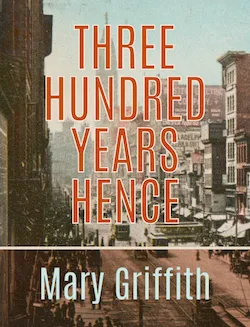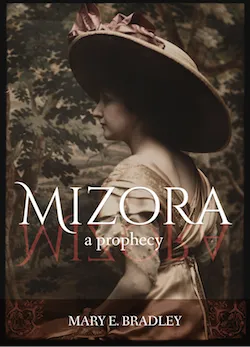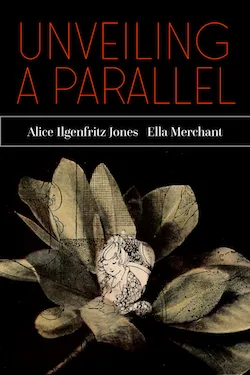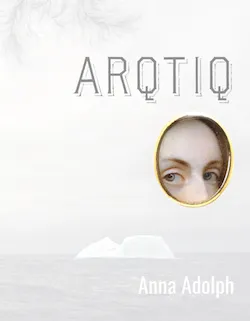Her stories: Fictional utopias of 19th century women
Utopian novels teach us about the hopes, fears, and prejudices of women before the modern era—and can still surprise us.

Edward Bellamy’s novel Looking Backward (1887) is about an accidental time-traveler who wakes up in Boston in the year 2000. Though not the first novel of its kind, it’s the best-known of a short-lived genre: 19th century utopian fiction.
These utopian stories bear a superficial resemblance to science fiction—often set in outer space, lost worlds, or in the far future—but they have different narrative structure and goals. Early sci-fi tends towards adventure stories with a futuristic or fantastical plot; utopian novels of the 1800s are fictionalized political tracts in which futurism is the framing device.
Recipe for an 19th century utopian novel
Hero travels to the future (or another planet, or a lost world) via some flimsy plot mechanic: a sudden deep sleep, an avalanche, a spontaneous journey in an “air-ship.” A comical number of stories involve our traveler just falling into a hole.
The protagonist meets a friendly companion with infinite free time who explains how their society works in excruciating detail. This is 80% of the book.
A hasty wrap-up, usually one of:
- Male protagonist marries an ethereal young woman in socialist paradise.
- Protagonist bids socialist paradise a fond farewell and returns to their own time.
- Actually, it was all a dream.
I say all this with affection because I love these stories. I have a fondness for the weird creativity associated with newborn genres, and these novels reflect authors grappling with the limitless world-building possibilities of sci-fi.
A brief history
Utopian novels were published sporadically throughout the mid 1800s, but Bellamy’s novel was a hit and triggered a tsunami of copycats, many by one-time authors who are otherwise unknown. After I read a few of them I got the idea for a mystery based on the relationship between these novels and the real-life utopian colonies that were cross-pollinating at the time; the result was my interactive fiction story Harmonia.
An indiscriminate selection of 19th century utopian novels would result in reading about a lot of people falling into holes, so this piece focuses on the small number written by women.
Women’s work
Utopian fiction represents the bulk of women’s sci-fi until well into the 20th century. It’s an opportunity to hear from under-represented voices about the futures they wished to see, at a time when their voices on public policy were minimized or absent. I also found them more compelling to read than the men’s stories; women’s utopian worlds are rich with detail about sexual politics or communication technology or home automation. I find that more approachable than a fictionalized treatise on nationalized coal industries.
Three Hundred Years Hence (1836)
Mary Griffith
This is the first-known utopian novel by an American woman. The earliest by any English-speaking woman is The Blazing-World by Margaret Cavendish in 1666, which is easier to appreciate than to read.
Edgar Hastings, the protagonist in Three Hundred Years, falls asleep in a snowbank and awakens on his family farm in the titular future. His guide is one of his own descendants—also, confusingly, named Edgar Hastings—who takes him on a tour of the mid-Atlantic states. The guide quotes extensively from a history book about “our” time called The Recorder of Self-Inflicted Miseries (a good alternate name for Twitter).
It’s sobering to me how banal the early utopian futures are. There are no hover cars or jetpacks. Paradise is a world where steamships don’t explode, where unspoiled meat is weighed on accurate scales, and every house is blessed with stacks of ice in the yard. The protagonist is astonished that basic travel is no longer life-threatening:
Hastings observed that there were no dangerous passes, for a strong railing stretched along the whole extent of every elevation. How different from the roads of 1834! Then men were reckless or prodigal of life; stages were overturned, or pitched down some steep hill—rail cars bounded off the rails, or set the vehicles on fire±steamboats exploded and destroyed many lives—horses ran away and broke their riders’ necks—carts, heavily laden, passed over children and animals—boats upset in squalls of wind—
Many of these novels address race in some way; these references are at best cringeworthy and at worst fully white supremacist. Griffith’s solution to the “negro problem” was to claim that the entire African-American population had been peacefully resettled in Liberia. This initiative reflected the real-life efforts of the American Colonial Society to resettle Black Americans in the African continent. The largely white ACS, composed of strange bedfellows from across the political spectrum, did relocate thousands of African-Americans, but was overwhelmingly opposed by Black leaders. “They would never have arrived at their present happy condition if they had sought to obtain their freedom by force,” Griffith writes, in one of the least prescient parts of the novel.
The protagonist then asks, “The Indians—what has become of them, are they still a distinct people?”
Unsurprisingly, the solution to the “Indian problem” did not involve resettling white Americans in Europe. In a genuinely strange narrative choice, the author poses the question and then fails to resolve it: “I must not speak of it!” her future guide says, evasively, and then the novel comes to an abrupt end, because it was all a dream.
The Republic of the Future (1887)
Anna Bowman Dodd
Dodd’s short novel is worth reading in full: this is a wryly comic dystopia with elements that would appear again in 20th century fiction from 1984 to “Harrison Bergeron”. It’s one of the few books in this list that relies on neither time-travel nor the all-knowing friendly companion.
In 2050, a visitor to “New York Socialistic City” (!) from the capitalist paradise of Sweden (!!) writes home about how soulless and uninspired America is now that everyone’s needs are satisfied by the state and no one is allowed to excel. I particularly like the opening scene, after the protagonist arrives by undersea pneumatic tube, when he checks in to an utterly empty hotel operated by steampunk automatons:
The great hall of the hotel was as deserted and silent as an empty tomb; at first I could not even discover a bell. Presently, however, I saw a huge iron hand pointing to an adjacent table. On the table lay a big book with a placard on which was printed, “Please write name, country, length of stay and number of rooms desired.” All of which I did. The book then miraculously closed itself and disappeared! The next instant a tray made its appearance where the book had been, on the tray was a key, and on the key a tag with a number and the words, “The elevator at your left to third right.” The elevator as I stepped into it, stopped as if by magic at the third story, when another iron hand shot out of the wall, pointing me to the left.
Honestly it sounds kind of awesome and I would totally stay here, especially in an era when social distancing is appropriate:
Meals are served in one’s own room, by a system of ingenious sliding shelves, which open and shut, and disappear into the wall in the most wizardlike manner. […] I amuse myself with perpetually testing all the bells and the electrical apparatus, calling for a hundred things I don’t want, to see whether they will come through the ceiling or up the floor.
There isn’t much in the way of a plot; our Swede drifts around a New York City “as flat as your hand,” in which all the buildings look the same, all the stores sell the same goods, and everyone wears the same “hideous” clothes: “They have the look of people who have come to the end of things and who have failed to find it amusing.”
Women get the vote and war is abolished, but only because war involves diplomacy and men find arguing with women to be too tedious to endure. “Husband and wife are in reality two men having equal rights, with the same range of occupation, the same duties as citizens to perform,” her protagonist writes, disapprovingly.
Mechanization has led to a drastic decline in working hours. “Recently a law has been put into effect, forbidding any one’s working more than two hours a day.” The victims of socialism can do little with their newfound leisure time because they are prevented from true creative expression: “A strict law was passed, and has since been rigidly enforced, forbidding mental or artistic development being carried beyond a certain fixed standard, a standard attainable by all.”
The book ends on Christmas Day, a holiday which is celebrated as a cautionary tale for children:
There was a play in which Santa Claus appeared and a number of other legendary characters, to show the children in what mythological, absurd beings the children of the unenlightened nineteenth century believed in. Then ten thousand toys were distributed, dolls and whips and tops, and sleighs and skates. But as all were distributed indiscriminately by State officers to the children as they passed out on review, of course all the boys got the dolls and the girls the whips and tops.
I mean yeah, not a great idea to give any children actual whips, but the rest of it sounds like a pretty good utopia.
Mizora: A Prophesy (1889)
Mary E. Bradley Lane
The women of Mizora live deep beneath the Arctic, in a society which has eradicated men. Lane wrote her novel in secret, even from her husband, which, given its content, is understandable.
This is far from the dreary future of Republic of the Future: Mizorans are educated, refined, tall, lovely, dignified, and melodious to the point of nausea. Again it’s instructive to note what counts as far-fetched social reform:
“You will never realize,” said the Preceptress earnestly, “the incalculable benefit that will accrue to your people from educating your poor. Urge that Government to try it for just twenty years.”
Mizorans buy food without fear of adulteration or spoilage, wear clothing of ubiquitous high quality, and walk on clean streets swept nightly by machines. Animals are wholly extinct. Clean hydrogen power and heat are supplied to every home, as “their coal mines had long been exhausted.”
There’s even wi-fi:
It is hardly necessary to state that letter-writing was an unknown accomplishment in Mizora. The person who desired to converse with another, no matter how far distant, placed herself in communication with her two instruments and signaled. Her friend appeared upon the polished metal surface like the figure in a mirror, and spoke to her audibly, and looked at her with all the naturalness of reality.
In short, this is one of the most richly realized utopian novels. And yet, the lesson we are meant to take from this, the first step on the path to this perfect society, is a terrible secret presented as bland historical fact:
“We believe that the highest excellence of moral and mental character is alone attainable by a fair race. The elements of evil belong to the dark race.”
“And were the people of this country once of mixed complexions?”
“As you see in the old portraits? Yes,” was the reply.
“And what became of the dark complexions?”
“We eliminated them.”
The novel ends on a sour note: one of the ethereal Mizorans is dead, and our protagonist realizes she belongs in neither our world nor theirs. She knows what we must do, though: “Though we cannot hope to attain their perfection in our generation, yet many, very many, evils could be obliterated were we to follow their laws. Crime is as hereditary as disease.”
This novel is horrifying, and worse, was not meant to be so.
Unveiling a Parallel (1893)
Alice Ilgenfritz Jones and Ella Merchant
…the planet’s pink envelope interposed its soft resistance to prevent a destructive landing. I settled down as gently as a dove alights, and the sensation was the most ecstatic I have ever experienced.
Arqtiq (1899)
Anna Adolph
Finally, this strange masterpiece of outsider art.
Like Mizora, this is a story about a lost society discovered deep beneath the (spoiler alert) Arctic — here a race of peaceful giants bathed in the glow of the aurora borealis, which shines from inside the hollow earth. More mystic than utopian, the book follows the female narrator as she is first gifted with telepathy, converted to the giants’ ideal of an all-encompassing oneness with God, and then taken on a spiritual pilgrimage through the center of the earth and into space. (Unfortunately, it is all a dream.)
Singular among the utopian novels I read, this is not the story of a lone adventurer, and it is not a thinly-veiled political tract. The narrator brings along her father, husband, and, improbably, a random little girl, and the writing is by turns incoherent and hypnotic. When I casually looked up the author for this piece, I found—nothing. Anna Adolph’s history online was a complete blank.
So I did some of my own research, and, well, it got complicated.
Other utopian or early science fiction by women
Five Generations Hence (1916), by Lillian B. Jones Horace, more a social critique than utopian fantasy, and perhaps the first by a Black American woman
Moving the Mountain (1911), by Charlotte Perkins Gilman (also the author of Herland)
“A Divided Republic” (1887), short story by Lillie Blake
Transcendental Wild Oats (1873), short story by Louisa May Alcott, a fictionalized version of her family’s time at the failed Fruitlands community
Repository for public domain utopian novels
Contributions or corrections to these or other titles are appreciated!
lizadaly/utopia-novels
utopia-novels - A small collection of 19th century utopian
fiction




